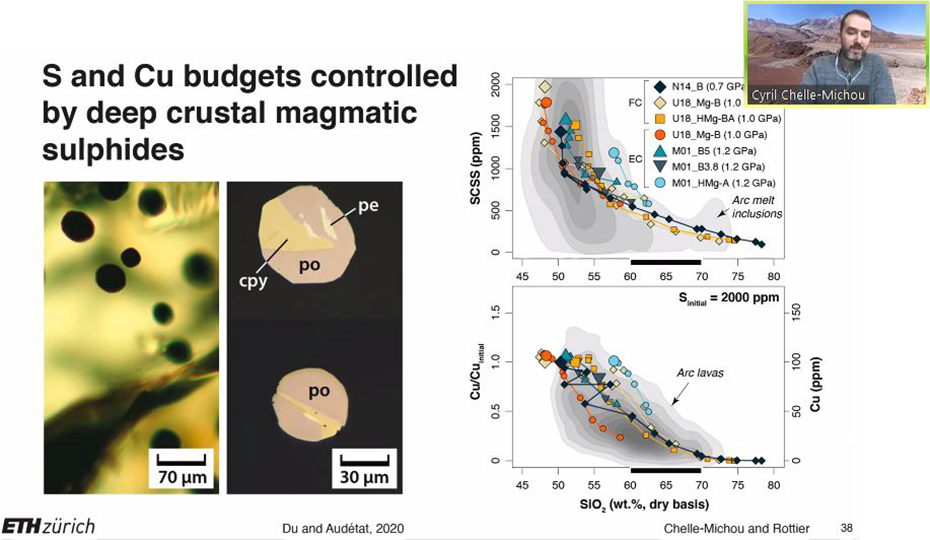The role of economic geology research in the 21st century
Prof. Chelle-Michou kickstarted the year 2021’s first colloquium at the ISTP. His insightful lecture covered the increasing demand for mineral resources and the geological plausibility of solving this problem. We would like to warmly thank him for his time and for sharing his research with us.
by Najmeh Karimian-Marnani and David Metzger

Demand for mineral resources is increasing exponentially due to population and economic growth. The vast amount of different products we consume rely heavily on metals and minerals obtained from the ground through mining, which has enormous environmental, and also economic, costs. Research estimates that an average person uses 50 tonnes of metals and 500 tonnes of industrial minerals in their lifetime.
The transition to a low carbon society to halt climate change, laid out in international climate agreements, needs technologies that also rely heavily on metal and mineral use, which unfortunately presses for a greater increase in demand. As it gets increasingly more expensive to find and build new extraction sites, accurate geological estimation gets more important.
Chelle-Michou and his Group of Mineral Resource Systems are doing research on the factors that determine the size and location of copper deposits. They found that the magma’s chemical composition is much less important than previously thought, and are exploring new avenues of research by looking at the temperature evolution during the pluton formation, combining knowledge from different earth science disciplines.
By how much should mineral resource extraction increase to meet the demands of consumption and the transition to a low-carbon society?
To meet the demands of the Paris Agreement, an increase in 1000% of Lithium (needed for batteries) is required. Copper, a metal that requires a comparatively lower increase, needs a 7% increase to meet the zero carbon demands, not counting the amount needed for general economic growth. This 7% translates to producing 1 billion tonnes by 2050 and 2 billion tonnes by 2100. Over the last century, the biggest copper mine has only produced 35 million tonnes. This is minute compared to the projections and raises the question of whether, with current methods and technologies, the projected demand is possible to achieve. It also shows the urgent need for changing our ways of producing and consuming: we need to close resource cycles, make repairable products, and perhaps even degrow our economies, to lead more fulfilling lives with less material throughput.
How can the supply of metals and minerals be increased?
It is clear that the mining industry must address and overcome the challenge of increasing the production of metals and minerals, while also reducing costs and environmental impact. One way to do this is by opening new mines. However, there are strict criteria for doing this, namely the geology of the region, the local conditions and its political/societal impact. As a result, new mines are also more economically, socially and environmentally costly - in terms of infrastructure, pollution, accessibility (deep crust), as well as increased political and societal resistance. Therefore, it is very important to not only determine the occurrence of copper deposits, but to also accurately predict the size of these deposits, evaluating whether the benefits of a new mine outweigh the costs and risks.
Chelle-Michou and his Group of Mineral Resource Systems are working on this knowledge gap by
- Quantifying the role of various geological processes in modulating the formation and size of mineral deposits
- Critically and quantitatively reassessing existing paradigms
- Looking for a way to estimate the size of mineral deposits as early as possible in the exploration process.
What are porphyry copper deposits?
Over 60% of copper comes from porphyry copper deposits. This type of deposit is formed by a magmatic-hydrothermal expulsion of overpressured fluids through porphyritic rock, or in layman’s terms, there is some water in the magma which is forced to flow through granite rock at a specific location and at high pressure and temperature, which leaves behind copper-rich minerals in the rock in the process. Typically these deposits form at the boundary of tectonic plates (subduction zones).
Size, temperature and time - a new way forward to identify large deposits?
Dr. Chelle-Michou and his group found that the magma’s chemical composition is much less important than previously thought. They are finding new insights is by looking into the physical conditions under which large deposits have formed, namely magma chamber size and temperature over time, for example to determine if the magma has cooled gradually or if the temperature has oscillated over the cooling process (on the time scale of millions of years). A longer, oscillating cooling process might be associated with increased mineralisation during the pluton formation, but more research is needed in different locations to confirm this hypothesis.
Economic geologists are used to looking only at the deposit itself, but they need to work with geologists, volcanologists, petrologists and geophysicists in an interdisciplinary effort to gain more insight into the formation process.
To get a broadened sense of the ISTP and our topics of interest and past seminars visit our Colloquia page.